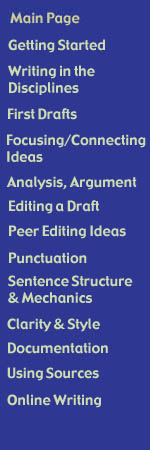

Effective Reading Strategies
Amy Addison
(printable version here)
Reading and writing are very closely related. If a writer doesn't understand the material they are reading, chances are they will not be able to write about it sucessfully.Therefore, a writer improving their reading skills may very well have a positive effect on their writing. The following are a few tips on how to get the most out of a reading:
- Don't wait until the last minute; leave plenty of time to read the material.
- Establish an atmosphere conducive to maximum concentration. This atmosphere will vary depending on personal preferences.This can include eliminating distractions such as phones and laptops.
- Look over materials before delving into them, noting headings, bold-faced words, charts, and summaries. Skim introductions and conclusions. By previewing materials, a writer can develop a sense of the overall point(s) it is presenting.This can provide context for a closer reading later.
- Use the questions at the beginnings or ends of chapters as study guides to help focus the reading.
- Read everything, including introductions and conclusions! ( Pro-tip: Footnotes and endnotes can contain great explanations and other resources).
- Look up unknown words.
- Try one or more of the following methods of note taking:
- Glossing: after reading a passage or section, summarize the main ideas in the writer's own words. This summary can be done in a notebook, on sticky notes, or even in the margins (as long as it's the writer's book).
- Outlining: using the author's order or one that makes sense as a writer, write down the key ideas. Use phrases and abbreviations to keep it short. Use whatever system of numbering or lettering works for the reading. Also see Topic outlines( insert link here)
- Synthesizing chart: chart key information when trying to pull together information from more than one source OR read from a few sources and formulate questions from the main ideas which can be applied to the remaining information.
- Instead of highlighting or underlining in the text, take notes in the margins or in a separate notebook. These notes will give you the important information at a glance. (If the writer takes notes in a separate notebook, remember to write the page number on which the information may be found again for later reference.)
- Another technique, combining several of those above, is that of the double sided notebook. After dividing a sheet of paper in half, the writer can copy key words and verbatim quotes on the right-hand side. On the left hand side, they can record impressions and thoughts in their own words. This technique ensures thorough reading along with comprehension.
Back to 'Getting Started'
Writer's Web | Writing Center | Make
an Appointment | Library
Copyright Info
Checked & proofread, summer 2018, Griffin Myers, Writing Consultant